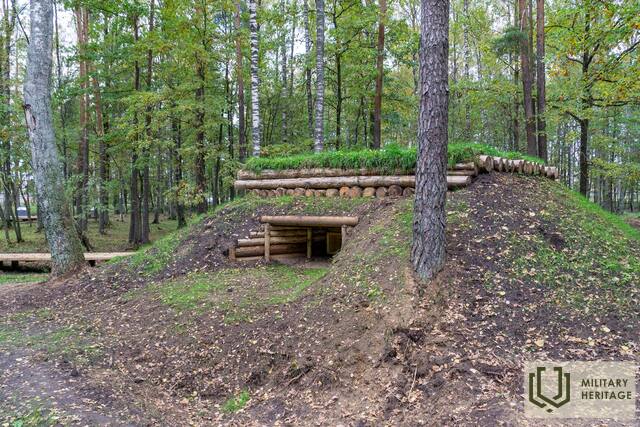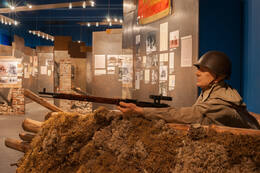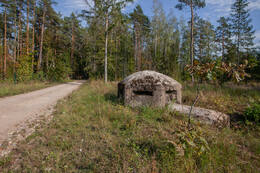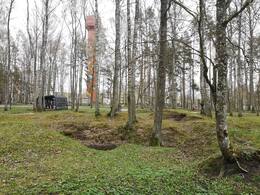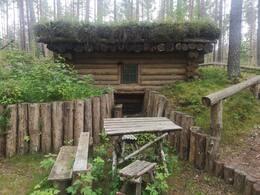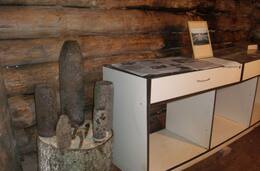Ekranavimas
I WW1, I Nepriklausomybės karai, II WW2, IV Sovietų okupacija
Taip pat bunkeris, iš prancūziško blindažo. Kariams gyventi skirta medžio ir žemės įtvirtinimo konstrukcija, apsauganti nuo artilerijos ugnies.
Dingo konstrukcija dažniausiai primena rąstinę trobą, visiškai įkasta į žemę. Šios struktūros buvo pastatytos daugiausia siekiant aprūpinti būstinę, lauko ligonines ir personalo poilsio zonas.
Vienas svarbus veiksnys yra konstrukcijos nematomumas. Tai leidžia užtikrinti aukščiausią įmanomą personalo saugumą.
Priklausomai nuo turimų medžiagų, žemės pastogių statybai gali būti naudojamos žemės, medžio, gelžbetonio, akmens ir metalo konstrukcijos.
Susijusios vietos
Latvian War Museum
The Latvian War Museum is located in the Old Town not far from the Freedom Monument in a historic defence building called the ‘Powder Tower’. There are 11 exhibits in the museum. There are various weapons, documents, uniforms, awards, badges and other items detailing the everyday life of a soldier in war. The Latvian War Museum is one of the oldest museums in Latvia. Its origins can be found in World War I. Museum’s collection was made up mainly of personal items of soldiers or items found on battlefields. After Latvia gained its independence the main goal of the museum became to create an exposition on the military history of Latvia and the active role of the population in protecting their land. In 1937 the museum was expanded and was technically one of the most modern museums in Europe at that time. The Powder Tower was one of the fortification towers of Riga. Some evidence dates back to 1330 where it has been mentioned as the ‘Sand Tower’. The tower was destroyed in 1621 when Riga was besieged by the Swedish Army. But in 1650 a new tower for storing gunpowder and weapons was built. After the city’s fortifications were taken down, the Powder Tower remains as one of the most important pieces of evidence of the Riga defence system.
Concrete bunker firing point near Gauja willage
It is located in Inčukalns municipality, on the side of the road near the village of Gauja, near the motorway A2 and A3 junction.
The fortification is a very rare and valuable example of a fortification. The building is designed for one person to observe an important traffic junction. In the NW direction there is a bridge over the Gauja, A - crossing over Inčupīte, SW - road branching and D - one of the main traffic roads - Vidzeme highway. The reinforced concrete fortification was part of the surrounding trenches, the exact time of which is unknown. It was probably built by the German army during World War II. The site needs further research to clarify the information.
At the end of the 19th century, the surroundings of Inčukalns manor became an important traffic hub. During World War I, the place gained the importance of a defense area where possible warfare was planned. Fortifications were built near the traffic roads, Inčukalns railway station and the Gauja river crossing. The place retained its strategic importance in the following wars.
Nowadays you can see the fortification, which is freely available.
Latvian riflemen positions and trenches in Tīreļi
Latvian Riflemen dugouts and trenches in Tīreļi are located in Babīte parish, Mārupe municipality, in the vicinity of the Antiņi Latvian Riflemen Cemetery and the former medicine warehouse. During World War I this was the defensive position of Latvian Riflemen of the Russian Imperial Army. A complex of trenches and surface dugouts was built in the sandy hills. Trench or positional warfare is the best way to accurately describe World War I and emphasise the importance of fortifications. They were based on the research of military engineers and adapted to the environment and the development of new weapons. The everyday life of a soldier is a continuous improvement of defensive fortifications. Sometimes soldiers would give the dugouts names that reminded them of their homes and would help to forget about the reality of the war. Trench lines were complex defensive systems that were hard for the enemy to take. With the development of weapons these defences became even more sophisticated. The roofs of dugouts were reinforced to withstand artillery shells. Trenches were made in changing patterns and directions so that explosions would cause as little damage as possible. Movement passages had pockets that were used as short-term hiding spots during artillery fire, because they protected soldiers from shrapnel and rubble. Today part of the fortification has been restored and you can visit 3 restored dugouts and a 100 m long section of the trenches.
Privati kolekcija „Šeimos klėtis“ (Dzimtas klēts)
Privati kolekcija „Šeimos klėtis“ yra šeimos ūkyje „Ābeļu Putni ņi“. Nuo 2007 m. ši vieta supažindina su vienos giminės istorija per pasakojimus, daiktus ir atkurtą lauko slėptuvę. Lankytojai kviečiami susipažinti su Pirmojo pasaulinio karo, Latvijos kariuomenės, Antrojo pasaulinio karo, Brolių kapinių Rygoje ir Kalėdų mūšių istorija. Senovinėje klėtyje galima pa matyti rankomis siuvinėtas staltieses, pačių austus tautinius drabužius, indų spintą, slides ir net barono Korfo dovanotą vežimo ratą. 2011 m. pradėtas lauko slėptuvės iš beržo rąstų atnaujinimas. Joje įrengta krosnis, vietos miegojimui, o sten duose eksponuojami daiktai, susiję su Pirmuoju pasauliniu karu – indų šukės, nuotraukos ir jau surūdijusios ginklų dalys. Ekspozicija padeda įsivaizduoti Pirmojo pasaulinio karo scenas, aprašytas Aleksandro Gryno romane „Sielų pūga“. Daug dėmesio skiriama Vidžemės 4-ajam šaulių pulkui ir Ka lėdų mūšiams. Minimi žymūs žmonės: karys Robertas Suokas, palaidotas Brolių kapinėse Rygoje, rašytojai Aleksandras Grynas, Janis Akurateris, kompozitorius Arvydas Žilinskis ir kiti. Ekspozicijos teritorijoje galima pamatyti Pirmojo pasaulinio karo bombų duobes ir šaltinį, iš kurio kareiviai sėmėsi geria mojo vandens. Ekskursija trunka 1,5–2 val. ir vedama latvių bei rusų kalbomis.




